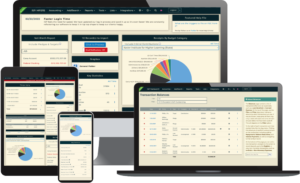Campaigns often get conduit (also known as earmarked) contributions that are passed through another political committee, such as ActBlue or WinRed. In these situations, you may be required to report both the original donor and the political committee, also called the Conduit. Conduits only apply when the organization doing the processing is a political committee. For businesses such as eFundraising, you just directly enter the contributions.
When it comes to the data entry of these transactions, it’s important to be sure you’re adding them correctly, as they can and will have an effect on Compliance reports
If you have a transfer coming from a conduit that won’t be sent until after the filing period closes, as is always the rule of thumb with ISP, enter what actually happened. Add the conduit check with the date that it was received and add each individual donor as splits with the dates that those donors made their original contributions. ISP will automatically handle getting this properly reported on your FEC report.
What are the different types of conduit transactions?
There are three types of conduit transactions:
- Conduit Checks: This is when a check or other transfer comes from conduit. It may include the donation from one or more donors and fees may be deducted. This is the most common method.
- Donor Checks: Where the donor has written a check directly to your committee but the physical check was passed through the conduit.
- Inkind: This very rare transaction takes place when a donor makes an inkind contribution to a conduit for the explicit purposes of assisting your campaign.
How do I enter these in the system?
Conduit Check and Donor Check Data Entry
Whether the check was from the Conduit or it was from the Donor, the data entry will be the same: the Conduit is the whole and the Donors are the Splits. Both Conduit and Donor checks are entered as Monetary Contributions as follows:
- Date: Use the date the check or transfer was received. For both Conduit and Donor checks, this applies to the FEC and most states but few states require that the postmark date is used. Please check your state’s laws.
- Amount: Enter the amount of the check or transfer. If fees were deducted, you should still enter the actual amount transferred.
- Tag: Select Conduit – Conduit Check or Conduit – Donor Check
- Splits: Enter each individual donor as a split. For their amount, choose the original amount they designated. Do not subtract out fees. No tags are needed on these splits.
Please see our separate help file on how ISP automates fee calculations and reporting.
Conduit Inkind Data Entry
These are entered as inkind contributions. The conduit should be the original donor. Enter as other inkind contributions.
- Date: The date the service/goods were received.
- Tag: Select Conduit – Inkind
- Splits: Enter the conduit. For the date use the date the conduit notified your committee of the inkind. Enter the same amount as for the main transaction.
State Reporting of Conduits
Not all agencies require conduit reporting. For many states, if you receive contributions via WinRed or ActBlue (or other conduits), you can report them as regular donations.
For example, WA does not require contributions received via WinRed or ActBlue to be reported as conduits. You can report them as direct contributions. However, in CA it is recommended you report them as received via a conduit.






